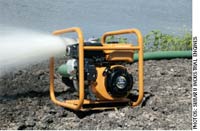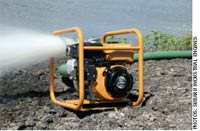
Play It Safe with Engines
The core of an internal combustion engine can reach 4,500 degrees F, and the exhaust pipe can reach 1,000 degrees. You must keep your cool when working with them.
- By Dale Gabrielse
- Jan 01, 2009
 From moving parts to flammable fluids, engines contain a number of materials that can harm a mechanic who’s not cautious. Some safety items may seem simple, but sometimes a little reminder can go a long way when the focus is on the job and safety measures are unintentionally neglected.
From moving parts to flammable fluids, engines contain a number of materials that can harm a mechanic who’s not cautious. Some safety items may seem simple, but sometimes a little reminder can go a long way when the focus is on the job and safety measures are unintentionally neglected.
The vapor from one cup of gasoline, when mixed with air in the right proportion, will have the explosive power of about five sticks of dynamite. That’s nothing to mess with. Clean up any fuel spills immediately, and discard the rags in a closed metal container. Carburetor cleaner and engine degreasers, along with the vapors, also are flammable and should be treated the same.
Storing fuel only in approved containers will prevent vapors and flames, as well. Blue kerosene cans are constructed differently than red gasoline cans and should never be substituted, nor should other storage containers, such as glass or plastic bottles. No matter what the container, never store fuel near an area with an open flame, such as an oil heater.
Some may disassociate the air filter with fuel—air is harmless, of course—but it’s important to use care when working on an air cleaner since the foam filter, when present, may be saturated with fuel or kerosene.
The heat produced by engines also makes them prone to spark, which can ignite combustible materials in the area, such as grass and dry leaves. Wood and grass ignite at around 400 to 600 degrees Fahrenheit, while the core of an internal combustion engine can reach 4,500 degrees and the exhaust pipe can reach 1,000 degrees.
Don’t Breathe It
A conscious decision about where the engine will be repaired or tested won’t just avoid fire, but also the deadly effects of carbon monoxide. The toxic fumes cannot be seen, tasted, or smelled. At lower exposure levels, carbon monoxide’s effects are similar to flu symptoms, including dizziness, headaches, disorientation, visual disturbances, nausea, and fatigue. The effects vary considerably from one individual to the next, however, since age and overall health can impact the degree to which a person’s body responds to carbon monoxide, as do the levels and lengths of exposure and the breathing rate due to the workload. In any case, don’t rely on these “symptoms” to serve as warning signals since hazardous carbon monoxide levels can develop within a matter of minutes, and death can occur quickly, before signs can ever be felt or noticed.
When running any engine, the repeated advice is to use it in a “well-ventilated location.”That’s a pretty ambiguous term, yet it seems to be the only guidance out there. So, will opening the door and a couple of windows suffice as “well-ventilated”?
Operating fans or opening doors and windows will never guarantee safety. A 1997 study published in the American Industrial Hygiene Association journal found that ventilation rates of 5,000 cubic feet per minute were needed to prevent the carbon monoxide level in a room from reaching the 200 ppm limit for exposure. So, what exactly does that mean? The National Institute for Occupational Safety and Health found that operating a 5.5-horsepower, gasoline-powered pressure washer in an 8,360-square-foot doublecar garage without ventilation would take five minutes to reach 200 ppm. Within 12 minutes, levels hit 1,200 ppm, and it was up to 1,500 ppm four minutes later. Levels continued to increase from there. When two double-car garage doors were open along with a window and the vent unsealed, it still took only three minutes to reach 200 ppm, and within 12 minutes the levels peaked at 658 ppm.
While the study indicates that hazardous levels of carbon monoxide can accumulate even in ventilated areas, the situation is considerably less dangerous than in an enclosed room. Mechanics should always try to move equipment outside when testing the machine. Keep it away from a building’s air intakes, which can pull exhaust inside.
This article originally appeared in the January 2009 issue of Occupational Health & Safety.